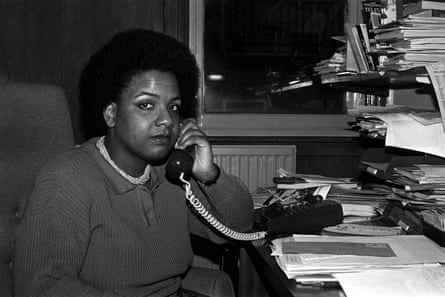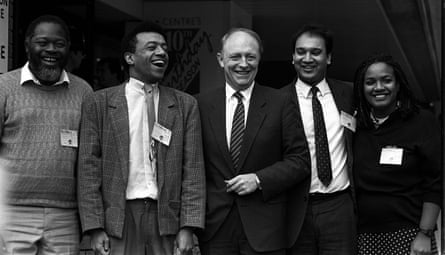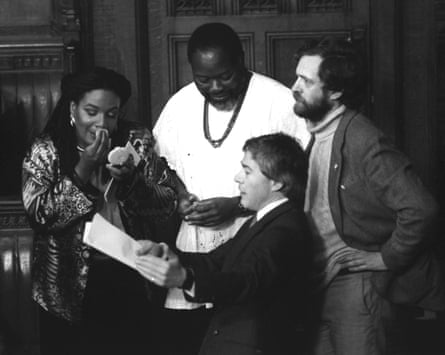The 1987 election campaign was the first time the Labour party had fielded so many black and Asian candidates. Yet Diane Abbott got the impression that “the national party thought we were an embarrassment”. Certainly, “they offered no support of any kind” and Labour’s party political broadcasts featured practically no black people.
The Tories, on the other hand, saw Abbott as an electoral asset – but not for Labour. Together with Ken Livingstone and Jeremy Corbyn, she featured on their “So this is the new moderate militant-free Labour party” advert. There were two versions: one that featured 24 faces and one that featured six; Abbott was on both. Abbott remembers getting more recognition from the Tory posters than from any Labour material.
Abbott and her team decided to go for broke. Rather than hiding the fact that she was black – the preferred option of the party leadership – Abbott told her designers to put her face front and centre, “so no one could be in any doubt”. The design reflected Abbott’s determination to run as herself, not as an identikit Labour candidate. This was a bold move. Although Hackney had been a safe Labour seat, politicians of all stripes assumed that white voters would not turn out for black candidates, and certainly not for black women. For her opponents, Abbott’s candidacy had put the seat into play. As a result, the fight for Hackney was fierce.
There were problems with support from her local party. “It was a tricky campaign, because some of the white activists wouldn’t work for me,” she says. Consequently, she recruited volunteers from local black organisations. Corbyn recalls learning of the problems in Hackney and sending volunteers from Islington North to help. John Burnell, who was selected as Abbott’s campaign manager, “decided to fight the campaign as if it was a marginal seat”. Another activist, named Peter Kenyon, who worked tirelessly for Abbott’s election, recalls that Burnell ran the campaign “like a military operation to maximise Abbott’s vote”.
The difficulties that Abbott had with the white working class were not lost on the SDP–Liberal Alliance. Simon Taylor, the Alliance’s candidate, told the Hackney Gazette that “Abbott had emerged as one of the issues on which his campaign would be fought because of her extreme views”. Taylor was not the only person to link Abbott with extremism. He claimed that he had “received considerable support among traditional Labour voters” who felt that Abbott did not represent them. Her Conservative opponent, Oliver Letwin, made much the same point, claiming: “If Labour had put up a sensible moderate candidate, then I don’t think I would have stood a cat in hell chance.” In addition to Abbott’s “extremism”, Letwin claimed that Abbott simply could not represent “ordinary voters”.

The campaign started traditionally enough. Abbott helped judge a cutest baby contest and took part in set-piece debates. However, the campaign soon became chaotic. The Conservatives’ Hackney office was firebombed, Abbott’s campaign headquarters had its windows smashed and there was an abortive march by the National Front to protest against her candidacy. Norman Tebbit visited the constituency and blamed the firebomb on “extremists”. Given the slew of claims that Abbott was an “extremist”, this could have been an attack on Abbott herself.
None of Labour’s big names joined Abbott on the campaign trail. An event with Bryan Gould was indicative of the leadership’s attitude. During the campaign, the Transport and General Workers’ Union (TGWU) invited Abbott to speak to Ford workers in Dagenham. Gould, Dagenham’s MP and Labour’s national campaign organiser, was horrified and tried to block the event. Abbott heard he initially refused to share a platform with her. Joe Gordon, the TGWU’s convenor, went ahead with the meeting regardless. He told reporters from the TV show The Bandung File that Abbott’s candidacy was “a tremendous step forward, as far as black people are concerned, for the Labour party”. In the end, Gould attended, but footage shows that he sat at the opposite end of the table to Abbott.
On entering parliament, Abbott’s stated ambition was to serve her constituents rather than seek promotion. As Labour’s leaders were keen to hold her at arm’s length, this was a sensible strategy. On the day that Abbott was sworn in, she was greeted by Lord Pitt, Labour’s only black peer. Pitt made a beeline for Abbott, meeting her in New Palace Yard. Abbott was also greeted warmly by her “little gang” of Corbyn, Bernie Grant and Tony Banks. Other Labour MPs were more wary. At the state opening of parliament, Abbott chose a spot on the green benches that had once been favoured by Enoch Powell, a symbolic act of decolonisation.

Abbott recalls that the Speaker, Bernard Weatherill, was clearly concerned about the arrival of the four new black and Asian MPs. As Abbott remembers: “This was the height of the ‘loony left’ scare and we were the epitome of the loony left.” The antipathy towards the new MPs was recognised on the Tory benches. Jonathan Aitken remembers that it began before the 1987 election. “There was a moment when, for the first time, it became apparent that, at the next election, Britain was about to have four or five black members of parliament. There were unpleasant rumbles in the House of Commons, saying: ‘These are awful people; they want to burn this place.’ There was a lot of that talk; it was, perhaps, tinged a bit with racism.” Aitken remembers that the Speaker was sufficiently worried that he called a meeting of a few trusted MPs to calm nerves ahead of the election.
The workings of the Commons were opaque and there was no induction for new MPs. One of the immediate problems was space. Abbott had no desk, no office, no base in the Palace of Westminster. She contacted Ray Powell, the Labour whip responsible for accommodation. There was no response. Abbott went repeatedly to the whips’ office, but he was never there. Having finally located Powell, she was told that she was second from bottom of the accommodation list. Dismayed, she still had the presence of mind to ask who was beneath her. Powell was candid and said that Livingstone had that honour. Livingstone recalls Powell was “a rightwinger who rewarded loyalists and punished rebels”. Evidently, Abbott and Livingstone were regarded as the least biddable MPs in the parliamentary Labour party.
The view that Labour’s new black and Asian MPs were a liability was shared across the house. This was plain from Abbott’s second appearance on Question Time, a week after the election in June 1987 (for the first, in 1986, she had received no briefing, coaching or support from Labour head office. “[Peter] Mandelson didn’t care if I fucked up,” she concluded then. “That was the issue with the Labour leadership all along; they would rather I fucked up than have any credibility at all. Mandelson was horrified by the rise of the left in London, horrified by black politics and what it meant. It showed me that these people weren’t on my side”). Abbott was on a panel with the Liberal MP Cyril Smith, the Conservative minister Michael Heseltine and Andrew Neil, the editor of the Sunday Times. As ever, Robin Day was in the chair. The polls, Smith commented forcefully, showed that Labour was unelectable – “and one of the reasons for it”, he added, “is Diane Abbott and people like her”. The largely white audience applauded and after a moment’s delay chuckled, seeming to get some unspoken joke. Abbott called him out: “If Mr Smith believes that having black people in parliament for the first time is in some sense a backward step, thousands of people that voted for me in Hackney North would disagree.”
The response was immediate. For Heseltine, this was beyond the pale. Horrified at Abbott’s insinuation, he appealed to Day to intervene. The audience protested vocally. “I honestly believe,” said one white man, “that the vast majority of the audience here do not see Diane as a black person.” This went down well with the audience, as did his comment that Abbott was the panellist showing true prejudice, for assuming that white people perceived race at all. Day wrapped up the discussion by apologising to the audience for calling Abbott black – his implication being that, unless he had said so, none of the white people in the crowd would have been able to tell.
Neil Kinnock, the leader of the Labour party, did make some effort to welcome Abbott to the Commons. After a few weeks in parliament, he invited Abbott and Keith Vaz to dinner in the members’ dining room. “Kinnock was obviously trying to be nice,” Abbott comments. Apparently, during the meal, he launched into an anecdote about a black boy at school who was nicknamed “Chalky White”.
The staff on the parliamentary estate also found it difficult to adjust to the presence of black and Asian MPs. “One of the things we found when we first entered parliament was that none of the attendants believed we were MPs,” Abbott says. She recalls that Paul Boateng, Grant and Vaz were stopped all the time as they moved around the estate. Boateng recalls that attendants constantly confused him with Grant, despite the age gap and the fact that Grant had a beard and Boateng was clean shaven. “They just saw black,” he comments. The serjeant at arms and the security staff, Abbott recalls, were particularly slow to learn.
Abbott was keen to hold events in parliament for her constituents and to support black groups. The first event of this kind started late simply because the security staff would not allow Abbott’s black guests into the building. On another occasion, the serjeant at arms presented her with a cleaning bill, even though, as far as Abbott could see, cleaning was completely unnecessary.

It was easier for black people to get in if they arrived alone. However, Abbott quickly spotted a pattern. Her black visitors were regularly sent to the Strangers’ Gallery rather than to see her. A letter from Abbott, Grant and Vaz, drafted by Abbott, to the parliamentary authorities from April 1988 complains: “Ever since my colleagues and I have been in the house, there have been a series of incidents that give rise to concern. Our visitors are sometimes treated less than politely and deliberately misled … Visitors and we ourselves have been jostled. We have been challenged by attendants as to our identity in an unsubtle attempt to embarrass us. These occurrences are too frequent and have been going on for too long.”
Abbott garnered a great deal of press attention following her election. Photographs of her at the state opening of parliament were published in tabloids and broadsheets alike, some commenting on her clothes, some on her hair, some on her makeup. The Sunday Telegraph magazine’s September feature on Abbott noted the interest in her style: “Gossip columnists have made the odd remark about her hips.” On this point, the author, Pauline Peters, remarked: “In fact, her only truly outsized attribute is the massive chip on her shoulder.” Writing in the Telegraph, Colin Welch bemoaned the fact that “it’s illegal to call her dusky or alluring”. Laziness was a common charge. In reality, Abbott had a larger workload than the vast majority of MPs. Corbyn recalls: “The four black MPs were inundated with casework from all over the country. Issues of racism, of discrimination, all the issues the black community faced.” As one of the first black MPs, Abbott represented a much greater community than the denizens of Hackney.
In the early 90s, parliament was organised for the convenience of men. The Commons regularly worked late into the night – and this was years before the introduction of a creche. Abbott, who married David Thompson in 1991, gave birth to her son, James, in October of that year. She received no maternity leave and was required to attend parliament and vote throughout her pregnancy. She gave birth on a Monday; the whips insisted that she work until the Thursday before, returning to parliament eight days later. “There was no flexibility, no support, no concern from the whips’ office; you were just expected to turn up and vote,” she says.
Abbott came up with a radical solution. On 31 October, she took her son through the division lobby. Seeing Abbott carrying her son in a blue sling, her colleagues complained to the serjeant at arms. Abbott voted, her son asleep in her arms. The serjeant at arms, however, later told Abbott that she had broken the rules and that such an infraction would not be tolerated twice. An unnamed Tory MP told the newspaper Today: “This is an outrageous breach of the rules. It’s bad enough having David Blunkett’s dog trooping through the lobby, never mind babies.”
Initially, Abbott brought over a cousin from Jamaica to live with the family and look after James. After she left, Abbott remembers the demands of the Commons were “nightmarish. You spent half the time thinking you were a terrible mother and half the time thinking you were a terrible MP.” She continued to bring her son into the Commons, particularly on Fridays, which was traditionally a quiet day. This shocked Nicholas Soames – not because Abbott brought in her child, but because she did not have a nanny. Things changed, Abbott recalled, when Nick Brown became a whip. Abbott credits Brown as being the first chief whip to take childcare seriously. “He would be lenient about letting me go home, especially if he knew I was going to vote against the Labour whip.”
In recent years, Stella Creasy, Ellie Reeves, Kemi Badenoch and Jo Swinson have followed in Abbott’s footsteps, bringing their babies into parliament. Yet Abbott’s son holds the record as the youngest person to enter a division lobby in the Commons.
In 1987, Abbott achieved her life’s ambition. Anthony Trollope once observed that “it is the highest and most legitimate pride of an Englishman to have the letters MP written after his name”. The same, Abbott maintains, is true for women. Being an MP is also the job that any working-class parent would want for their child, Abbott quips: “Clean, indoor work, with no heavy lifting.” And the constant bureaucratic micro-aggressions and slights from her colleagues across the house did not deter her.
This is an edited extract from Robin Bunce and Samara Linton’s Diane Abbott: The Authorised Biography, published by Biteback (£20). To order a copy for £16, go to guardianbookshop.com. Delivery charges may apply.